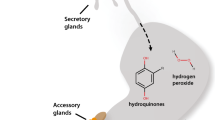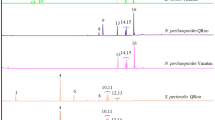Summary.
Beetles of the family Lycidae have long been known to be chemically protected. We present evidence that North American species of the lycid genera Calopteron and Lycus are rejected by thrushes, wolf spiders, and orb-weaving spiders, and that they contain a systemic compound that could account, at least in part, for this unacceptability. This compound, a novel acetylenic acid that we named lycidic acid, proved actively deterrent in feeding tests with wolf spiders and coccinellid beetles. Species of Lycuscommonly figure as models of mimetic associations. Among their mimics are species of the cerambycid beetle genus Elytroleptus, remarkable because they prey upon the model lycids. We postulated that by doing so Elytroleptus might incorporate the lycidic acid from their prey for their own defense. However, judging from analytical data, the beetles practice no such sequestration, explaining why they remain relatively palatable (in tests with wolf spiders) even after having fed on lycids. Chemical analyses also showed the lycids to contain pyrazines, such as were already known from other Lycidae, potent odorants that could serve in an aposematic capacity to forestall predatory attacks.
Similar content being viewed by others
Author information
Authors and Affiliations
Corresponding author
Additional information
David Utterback: Deceased
Rights and permissions
About this article
Cite this article
Eisner, T., Schroeder, F.C., Snyder, N. et al. Defensive chemistry of lycid beetles and of mimetic cerambycid beetles that feed on them. Chemoecology 18, 109–119 (2008). https://doi.org/10.1007/s00049-007-0398-4
Received:
Accepted:
Published:
Issue Date:
DOI: https://doi.org/10.1007/s00049-007-0398-4




